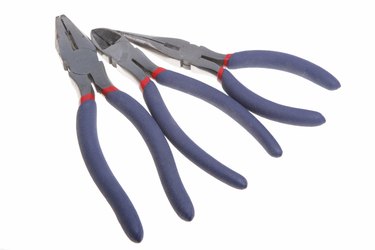
Woodworkers, cabinetmakers, shopkeepers, builders, electricians and construction workers often refer to edge cutters. They're typically asking for a tool with two knife-like edges at the ends, joined by an axle. With two handles to provide leverage, the cutting edges pinch together to cut wires, plastic, wood, nails, staples or just about anything else you can imagine.
Diagonal Pliers
Video of the Day
Diagonal pliers and scissors are among the most well-known edge cutting tools. Because of the position of their jaws, they're sometimes referred to as "edge-cutters" or "side-cutters." With steep, angled jaws that resist damage, diagonal pliers cut through wires, staples, nails and other materials with relative ease. Diagonal pliers have jaws that meet each other directly to form the cutting edge -- as opposed to snips or scissors that have jaws that pass each other. Diagonal plier jaws curve, and are also used for prying.
Video of the Day
Linesman's Pliers
Linesman's pliers are heavy-duty cutting tools. These side-cutting tools have a flat, crinkled end on the jaws that allow you to use them as standard pliers to grip, twist and pull. The cutting edges are just like diagonal pliers, but smaller. The handles allow you to apply more force than diagonal pliers deliver.
End Cutters
End cutters are similar to diagonal pliers with the steep, shallow cutting edge that can take punishment. Diagonal pliers cut from the side, but the jaws of end-cutters come together at the tip of the tool. The jaws of end cutters are perpendicular to the length, as opposed to the jaws of diagonal pliers that are parallel with the length. End cutters are handy for fence-building, and cutting through heavier strands of wire that diagonal cutters can't handle.
Electrician's Pliers
Wire strippers, or electrician's pliers, are edge cutters. With razor sharp edges that meet in the middle like diagonal pliers, they cut wires more precisely than other types of cutters. The cutting edges are delicate, and you shouldn't use wire stripping cutters to cut staples or nails because of possible damage to the sharp jaws. Additionally, electrician's pliers have an assortment of crescent-shaped cutters for cutting insulation from wires without damaging the core of the wire.
Slip-Joint Pliers
Almost everyone has a pair of all-purpose, slip-joint pliers around the house, and most of them come equipped with cutting edges. The two, block-like edges located just under the jaws serve as cutters, mostly reserved for wires, staples and nails. Needle-nose, long-nose, long-reach, flat nose and insulated pliers typically also have side-cutters just below the jaws.
Snips
Snips come in different sizes and shapes for various materials and tasks. The handles resemble scissors with finger and thumb holes, or have handles similar to pliers. Some models cut straight lines, others are reserved for curves. Left-cutter snips cut straight lines and curves to the left. Right-cut snips cut straight lines and curves to the right. Universal snips cut straight lines and curves in both directions. Offset snips come in any variety. The handle of the offset snip tilts upward to keep your fingers above the material to keep them safe. Snips, depending on their design, cut leather, tin, plastics, thicker fabrics or other mediums.
Scissors and Shears
Scissors and shears are used interchangeably as edge-cutting tools, and perform similar tasks. The difference is size and design. Scissors are typically smaller in length, with more customized finger holes than shears. Shears are typically longer, with bigger handles and thicker blades. Scissors and shears share two types of blades. Convex blades are rounded to cut smooth and delicately. Bevel-edge blades have a square edge, are less delicate and can be used with more force.